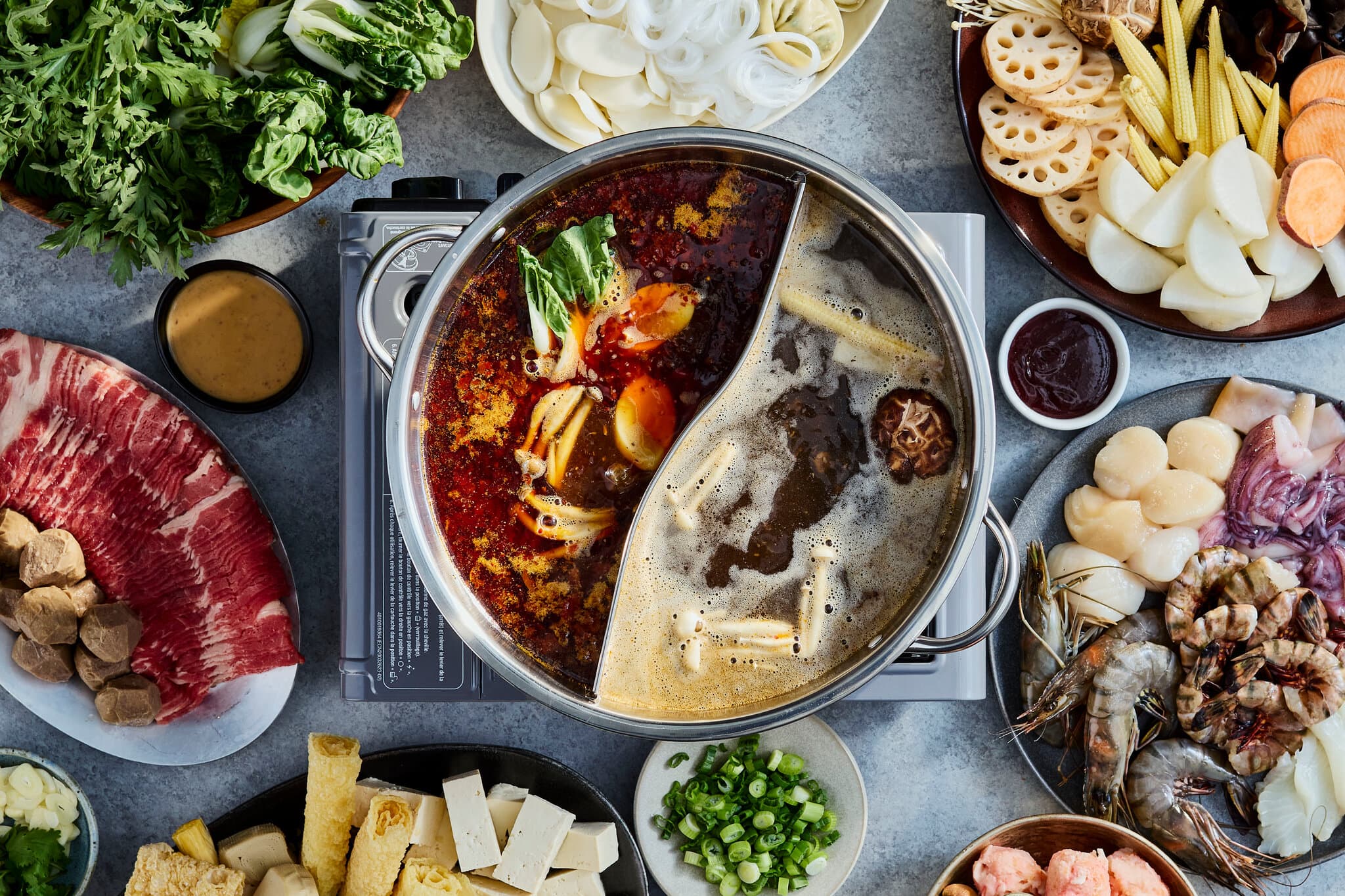
The Definitive Guide To Hotpot
What is Hotpot?
Hotpot (火锅) is a form of social eating where everyone gathers around and cooks food in a communal pot of flavoured broth. It’s one of the tastiest ways that you can feed a crowd with a minimum amount of hassle. It’s particularly popular for large gatherings, like during Chinese New Year; because everyone cooks their own food, all you need to prepare are the raw ingredients.
While hotpot is commonly associated with Chinese cuisine, it’s enjoyed in other places too: think Japanese shabu shabu, Thai suki, or Korean jeongol. The concept is simple and universal. All you need is a big pot of simmering broth and ingredients like meat, seafood and vegetables to cook in it; the specific flavours and ingredients are up to you.
This guide is a walkthrough to help you plan and run your own successful hotpot party at home. First, we’ll go over the equipment you'll need. Next, we’ll cover a few popular broths, followed by the ingredients and how to prep and cook them, as well as the dipping sauce condiments to serve alongside. At the end, we'll go over the basics of hotpot etiquette.
Equipment
Pot and Heater
You’ll need a pot to hold your broth and cook your ingredients in. You can use any pot in your kitchen, but it should be large enough to contain the broth and some cooking ingredients. A shallower and wider pot is ideal to make it easier to reach for ingredients and to find the ingredient you’re cooking. Look for a pot that can accomodate at least three litres of water per group of 2-6 people.
You can purchase specialised pots that are made for hotpots; some come with one or more partitions that allow you to cook with multiple broths in the same pot and add more variety to your hotpot. You can also use multiple pots if you have larger groups or want to cook with more broths.
You’ll also need some way to keep the broth simmering away. Popular choices include portable gas burner, which have the benefit of being cordless but will need additional butane gas canisters, and induction hot plates, which will not unexpectedly run out of gas (yes, it’s happened to me before), but will need a power source to plug into. Either way, choose an option that lets you control the heat so you can adjust the hotpot to simmer or boil as needed.
You can also purchase dedicated pot-heater combinations for hotpot that give you an all-in-one solution.
Utensils and Tableware
Each person needs at least one bowl to eat their cooked food out of. More bowls will be needed if you want everyone to have their own dipping sauce. Everyone will also need a pair of chopsticks to eat with, and a spoon to use to drink the broth (or slurp it straight from the bowl, we’re not judging).
You’ll also need to provide cooking ladles, strainers and chopsticks/tongs. If you have more, everyone can get their own individual tool, otherwise it’s perfectly fine for everyone to share communal tools. Chopsticks and/or tongs will help you to pick up the raw ingredients and add them to the pot (don’t mix them with your own chopsticks!), while cooking ladles will allow you to scoop out broth and strainers will help you take pieces of cooked food out.
Soup Bases
Now that you’ve got your equipment ready, you’ll need to decide on your soup base.
Soup bases can take any form of a seasoned and flavourful broth and there are no wrong options. Even a basic chicken or vegetable stock will turn out great. The important thing is to choose a flavour you like and will be happy to have from start to finish. You can also choose multiple soup bases for variety.
Your soup base will lend its flavour to every ingredient you cook, but will also pick up flavours from the ingredients, so the broth at the end will be a lot more flavourful. If you have to come late to a party, make it a hotpot party, because you’ll be working with a more delicious broth.
How much broth do I need?
How much you’ll need depends on how many people you’re feeding. I like to have 6 cups (1.5 litres) to start with for two people, adding an additional cup (250 ml) per additional person sharing the broth. This applies to each broth, so if you have a single pot with two broths, or two pots with a single broth each, you’ll need to double the numbers.
You can buy ready-made soup bases at grocery stores which only require you to mix in water, but making your own can be easy and more nutritious. Below, we’ll go through six popular options. You can click on a soup base image to open the recipe in a new tab.
Tomato Broth
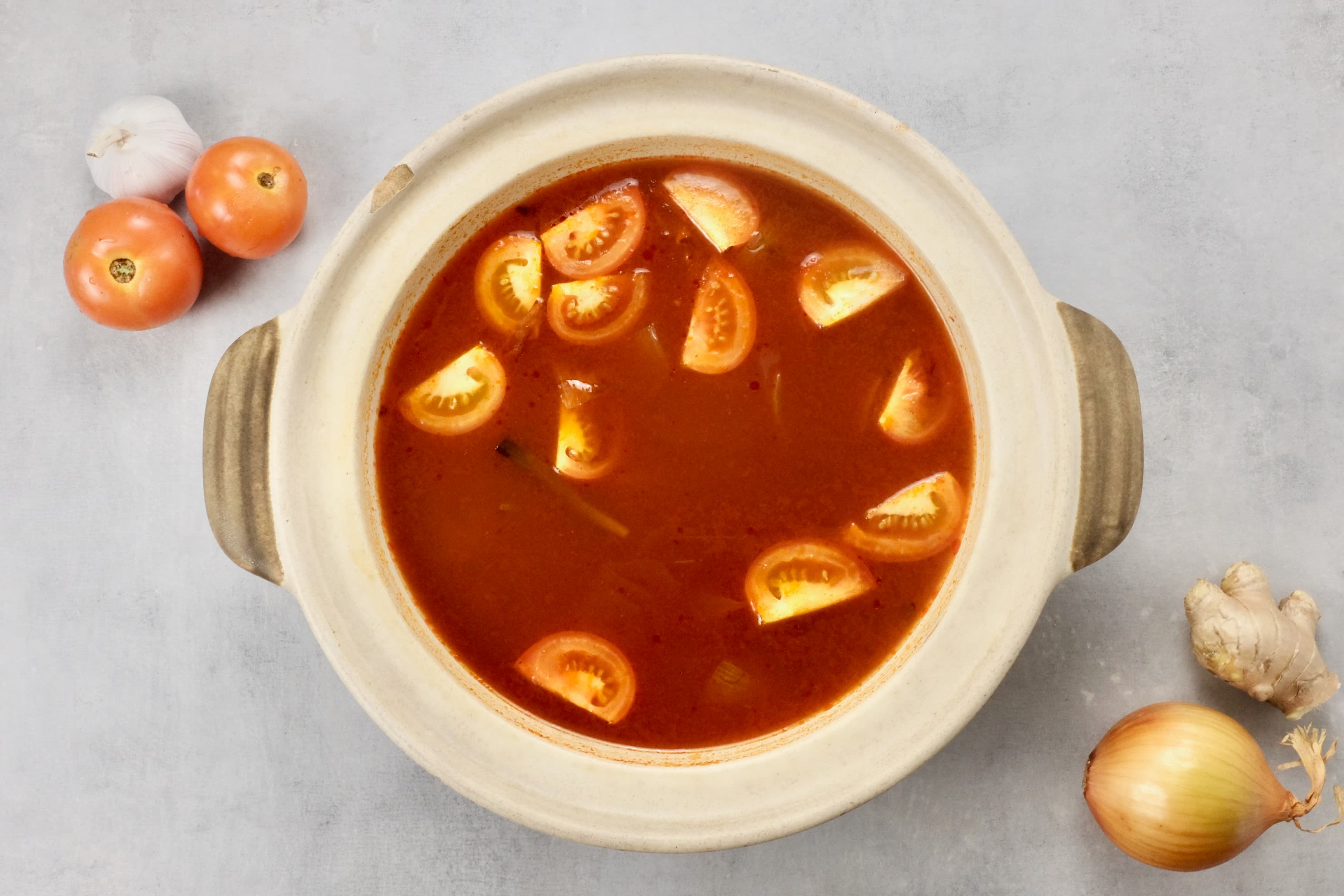
This features three preparations of tomato and is a mild, vegan friendly broth that comes together in half an hour and only requires pantry ingredients and a few aromatics. You start by sautéing onion, ginger, garlic and spring onion in some oil until fragrant, then add tomato paste, water, tomato purée and simmer for 30 minutes. Season to taste and garnish with fresh cut tomatoes. It’s subtly sweet, has a nice dash of umami, and is refreshing.
Good for: Tomato lovers, vegans and people who prefer a lighter broth.
Get the recipeMushroom Broth
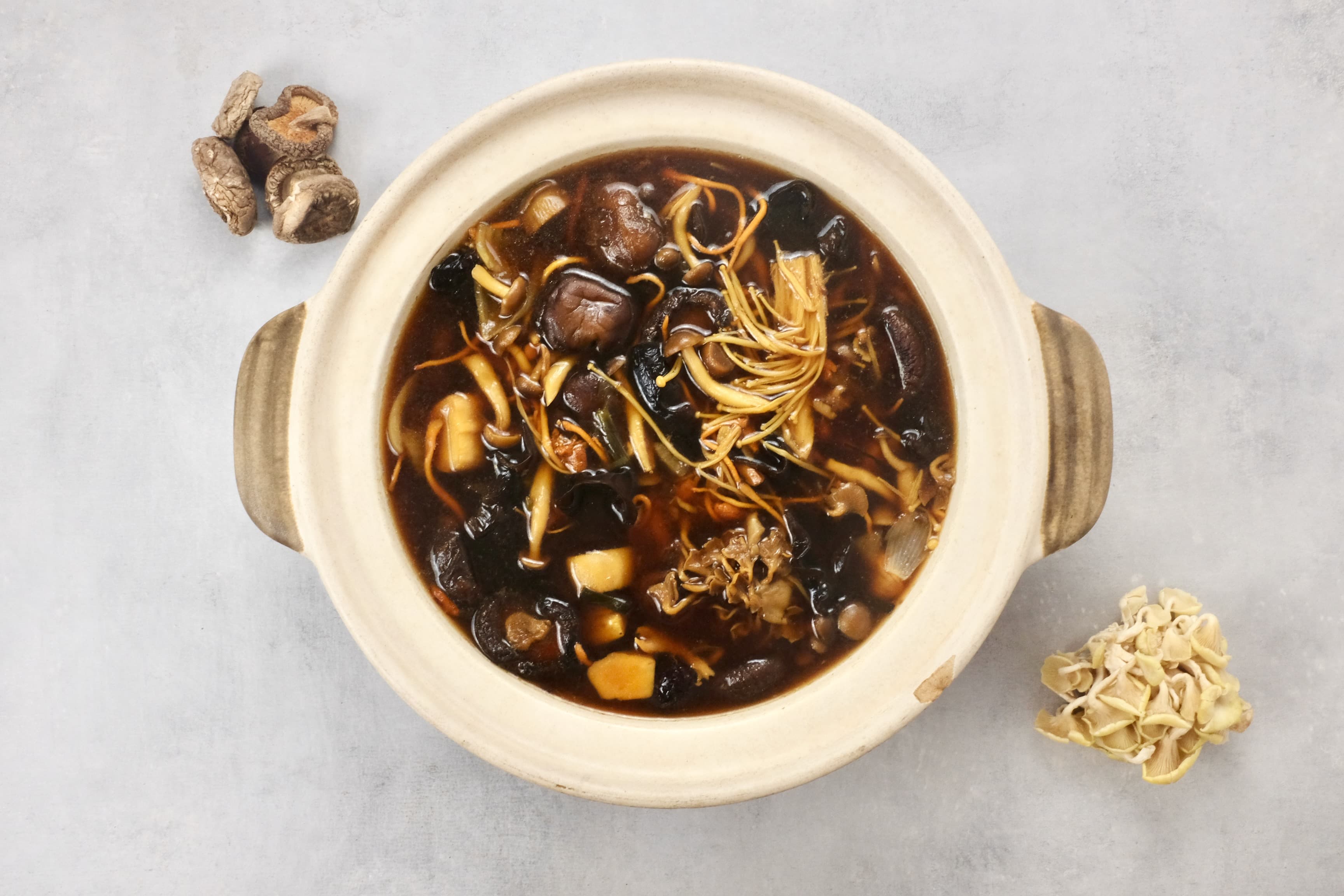
Inspired by the mushroom hotpots of Yunnan, this mushroom-forward broth takes less than an hour to make. Start by sautéing onion, garlic, ginger and spring onion, then add water, plenty of mushrooms, a few dates to add sweetness, and simmer for 45 minutes. It’s earthy, mushroomy and full of umami. Did we mention it’s also vegan?
Good for: Mushroom fans and vegans.
Get the recipeMala Spicy Broth
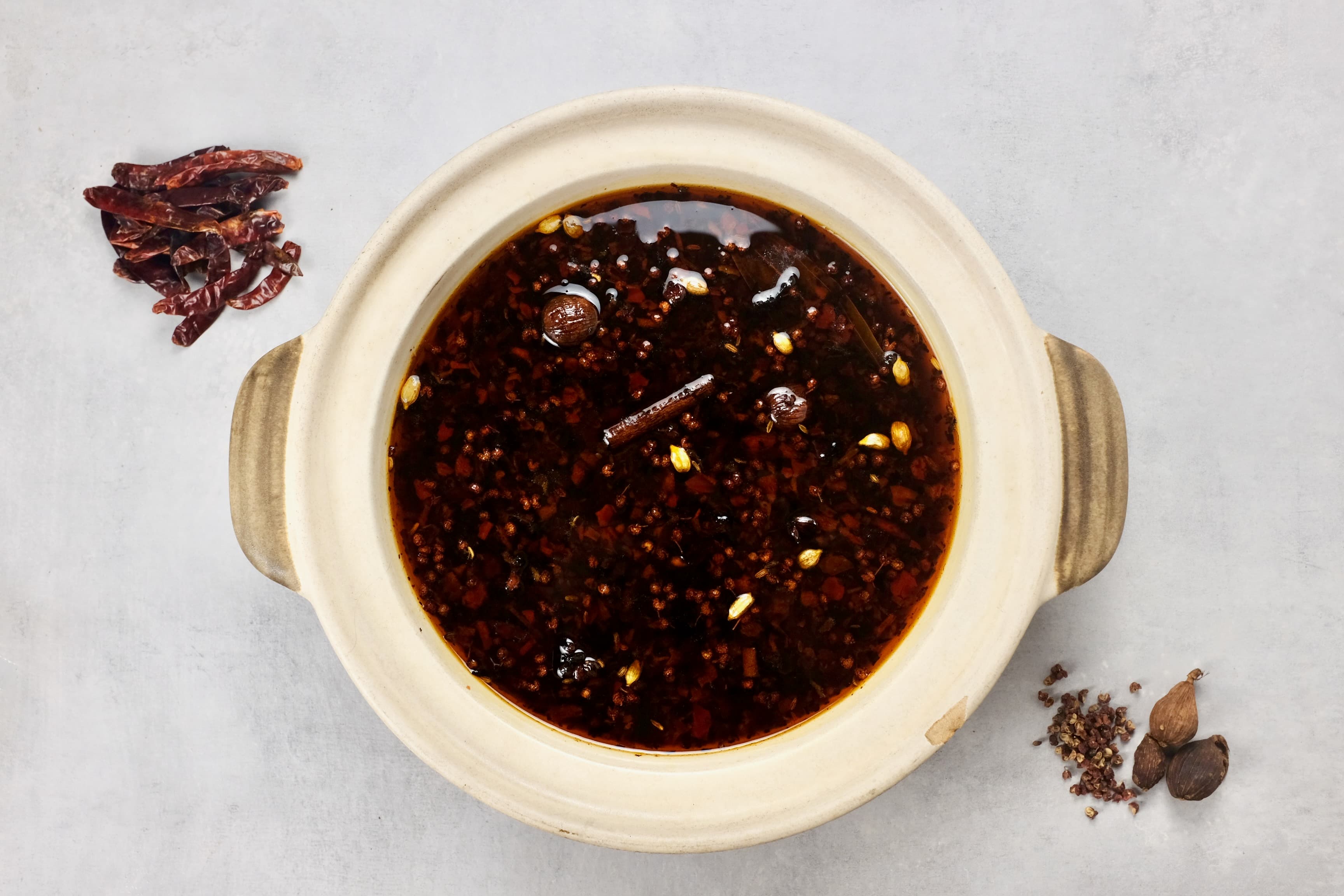
This is the soup base that many associate with hotpots, and for good reason. It’s spicy, numbing and puts the hot in hotpot. This one is a little more fiddly, but can still be done in an hour. Although beef tallow is traditional, we’ve used oil in this recipe to make it completely vegan without sacrificing much flavour. Start by rehydrating dried chillies, then blending them. Infuse oil with garlic, ginger and spring onion. Discard the aromatics, then add the blended rehydrated chillies to cook out before adding spices, including Sichuan peppercorns, chilli bean paste (doubanjiang), and fermented soybeans for flavour. Season, then add the chilli oil paste to water or stock and you have your broth. It’s tasty, spicy and tear-inducing in all the right ways. Feel free to halve the chillies and sichuan pepper used if you want a bit of spice but not too much.
Good for: Heat-seekers and vegans.
Get the recipeHot and Sour Broth
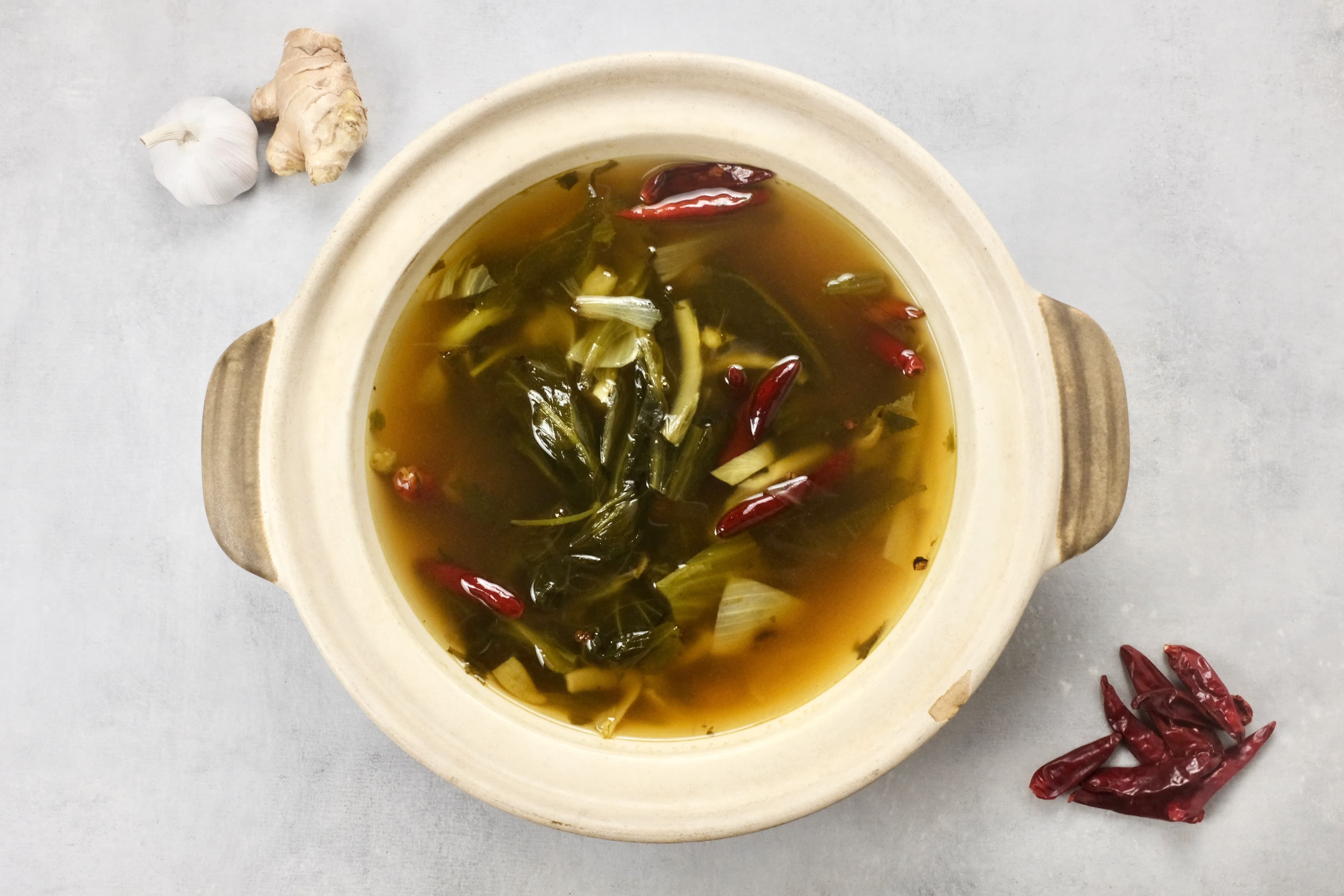
Ever heard of suancaiyu? It’s a spicy, tangy fish soup that gets its flavour from pickled mustard greens and chillies. This is a greatly simplified variation on that, just without the fish. Onion, garlic, ginger and spring onion are sautéed until fragrant, until fragrant, then pickled chillies, dried chillies and pickled mustard greens are added, along with a stock (use vegetable stock to keep this vegan), or just plain water. It’s boiled for half an hour, then seasoned. The result is a a subtly spicy broth (as opposed to the in-your-face heat of the spicy mala broth) that has a refreshing sour note which cuts through any heaviness. It’s perfect for dipping fattier meats and fish, obviously, pairs perfectly with it.
Good for: Hot and sour aficionados.
Get the recipeHerbal Chicken Broth
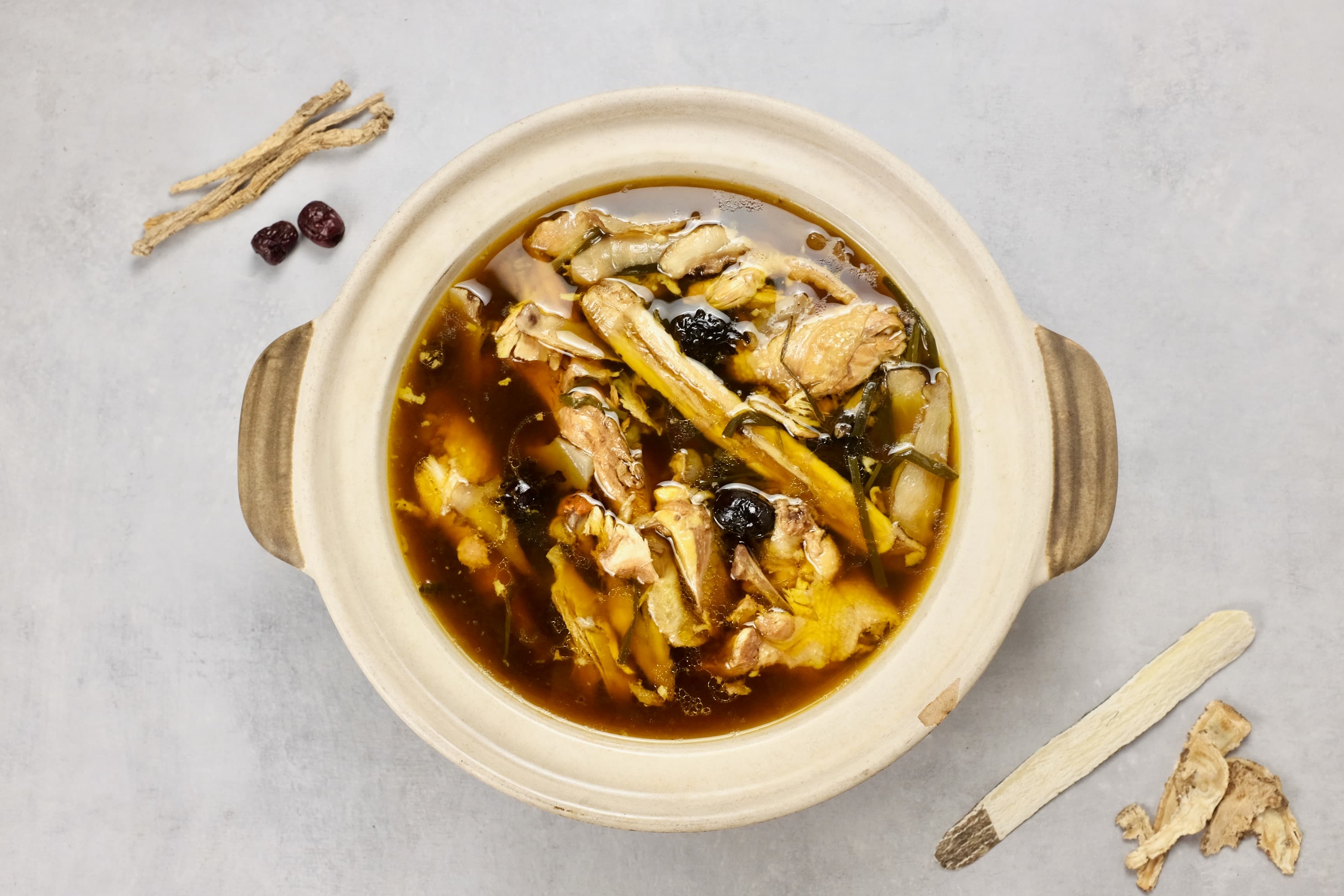
This might be the most hands-off broth on the list. Put a whole (or cut, it’s up to you) chicken into a pot, cover with water and add Chinese herbs, dates and aromatics, then simmer for 3 hours. It does take some time, but what you get is a broth that tastes delicious and feels nourishing. It’s a complete dish so you can even drink this broth on its own. But why would you, when you can make ingredients more delicious by cooking with it?
Good for: Those who want a healthier, but no less delicious, option.
Get the recipePork Bone Collagen Broth

If you’ve never tried a collagen broth, it’s basically a stock where the collagen content has been maximised. Each spoonful of white, creamy, broth has a thick, sticky mouthfeel that feels luxurious, but it can get a little too intense, which is why it’s commonly paired with a lighter, milder broth. To make it, you’ll need to boil a stock of pork bones, pork trotters, chicken bones and chicken feet for 6-12 hours to extract as much collagen and flavour as possible. Add aromatics in the last hour to season the stock, and that’s it. It’s simple to make, but does require a large time investment.
Good for: Those living their rich (flavour) life.
Get the recipeHotpot Builder
Customize your own hotpot menu.
Ingredients
What goes into your broth? The list is endless, but we’ve grouped ingredients into a few categories that you can use to plan your menu. For each category, we’ll cover a few popular options, but you can’t go wrong picking your own favourites.
Aim for variety and balance - get some protein (meat, seafood and tofu), and balance them out with a few vegetables and mushrooms. Throw in some dumplings and a carb or two (rice is always a good option, but it’s hard to say no to noodles) and you’ve got a veritable cornucopia ready to go.
How much ingredients do I need?
This is an indicative range of ingredient amounts and number of varieties per person. Get more for hungrier eaters.
| Category | Amount (grams) | Varieties |
|---|---|---|
| Meat and Seafood | 150-250 | 2-4 |
| Beancurd & Tofu | 50-100 | 1-2 |
| Vegetables & Mushrooms | 150-250 | 4-6 |
| Rice & Noodles | 25-50 uncooked 50-100 cooked | 1-2 |
How much prep time will I need?
Prep time can take anywhere from 30 minutes to 2 hours, depending on the amount and type of ingredients you’re prepping. Take that into account when planning your hotpot meal.
Meat
Just about any meat works for hotpot. The broth will take on the flavour of the meat as you cook it. Thinner slices are the way to go here, because they can be cooked in the broth in a matter of seconds to minutes. If the meat is too large, it’ll take a longer time to braise and take up valuable space in your pot. Chicken cooks relatively quickly, so you can get away with slightly thicker slices, but try to get paper-thin slices of beef, pork, and lamb either from your butcher (who should have access to a meat slicer), or look in the freezer section of the supermarket. In a pinch, you can slice them at home yourself. Place the meat in the freezer for half an hour to firm up, then slice them as thinly as you can.
Besides the usual meat cuts, you can also get them in other forms. Pork and beef balls, made from minced meat, are chewy and bouncy alternatives. Sausages and spam/luncheon meat are also popular options. If you’re feeling adventurous, consider offal like pork intestine, liver, kidney and stomach or beef tripe, stomach, and tendon.
To prep them for the hotpot, make sure all meats are fully defrosted and thinly sliced.
Seafood
All kinds of seafood are perfect for hotpot. Fish, prawns and squid are popular options, while shellfish like clams, scallop, abalone, or crab and lobster if you’re feeling indulgent, are also great choices. You can also opt for other forms like fish balls, fish cakes, crab sticks and shrimp paste, which all come in a variety of shapes and flavours.
Make sure all your seafood are in bite-sized pieces for quick and even cooking. To prep fish, slice into thin pieces, but don’t go too thin; fish is fragile and can break up in the broth. Clean prawns and shellfish well. You can leave prawns in their shell for more flavour, but make cuts in the shell to allow guests to remove the shells easily. Smaller shellfish like clams and mussels can be left in their shells, but larger ones like scallop and oyster should be detached. Crabs and lobsters will need to be broken down for easy cooking and retrieval.
Seafood doesn’t take long to cook, but can overcook quickly so be sure to pay attention. Processed items like fish balls and shrimp balls are more forgiving and can sit in the broth longer, but scoop them out when you see them floating, which is a sign that they’re ready.
Beancurd & Tofu
Tofu and beancurd come in many shapes and varieties. You can get them fresh, fried, and dried, and shaped in cubes, sheets, rolls, to name a few. They’re also inexpensive but contribute a lot in the texture department. Tofu and other beancurd products are a great protein alternative for people who don’t take meat or seafood. Unlike meat and seafood, however, you can leave your tofu in the broth almost indefinitely. With their propensity to absorb flavours, they’re essentially sponges for your broth and get better the longer they sit.
They also require minimal preparation. You’ll probably just need to cut larger tofu into smaller bite-sized pieces; most beancurd items can be dropped directly into the broth.
Vegetables
Meat and seafood may be the star ingredients of a hotpot, but don’t overlook vegetables. They balance out the heavier offerings and contribute plenty of freshness and flavour to the broth. Opt for a wide variety to add more interest. Whatever is in season will probably be best, but there’s no such thing as a bad vegetable in hotpot.
To start, wash and dry all vegetables. When preparing larger vegetables like corn, potato and daikon, cut them into thin slices or small chunks for quicker cooking. For smaller vegetables, including leafy greens like spinach, lettuce or cabbage, you can leave them as whole leaves or halve them if they’re too big.
The general rule is to cook them until tender. Leafy vegetables are less forgiving and can wilt if overcooked, while root vegetables have a larger window, but can break apart into your broth if left for too long. Check on them regularly.
Mushrooms
We love mushroom so much we had to give them their own section. Mushrooms are hotpot stars - they’re easy to prepare, add tons of flavour to the broth, are impossible to overcook, and are inexpensive. And they’re another great protein alternative for those not eating meat and seafood.
If you get a dried mushroom like shiitake or black fungus, cover them with some water and give them half an hour or so to rehydrate. Larger mushrooms will be need to be cut into smaller bite-size pieces. Some mushrooms will also need their roots removed.
Rice & Noodles
Carbs, depending on who you speak to, are either essential components of a hotpot menu, or completely unnecessary and only take up valuable space that should be allocated to other ingredients. Rather than wade into this controversy, we’ll share popular carb options and let you decide.
Rice is a perfect foil for hotpot. It serves as a bed for the cooked ingredients and soaks up the broth. If you’re going down the rice route, have your rice cooked (according to your rice cooker’s instructions) and ready to eat before you start your hotpot.
If you’re feeling more noodle-y, there are an infinite number of choices to consider, including ingredient (rice and wheat are popular options), shape (some like flat noodles, others round), and thickness (think kway teow vs pho). Ultimately, you should pick a noodle you want to eat because all of them are great options.
If you choose a dry noodle (as opposed to a fresh noodle), you might want to soak or par-boil the noodles before the hotpot. It’s not necessary, but par-boiling can help remove excess starch from the noodles that would thicken your broth and reduce the cooking time in the pot.
Hotpot Builder
Pick your favorutie ingredients.
Dipping Sauces
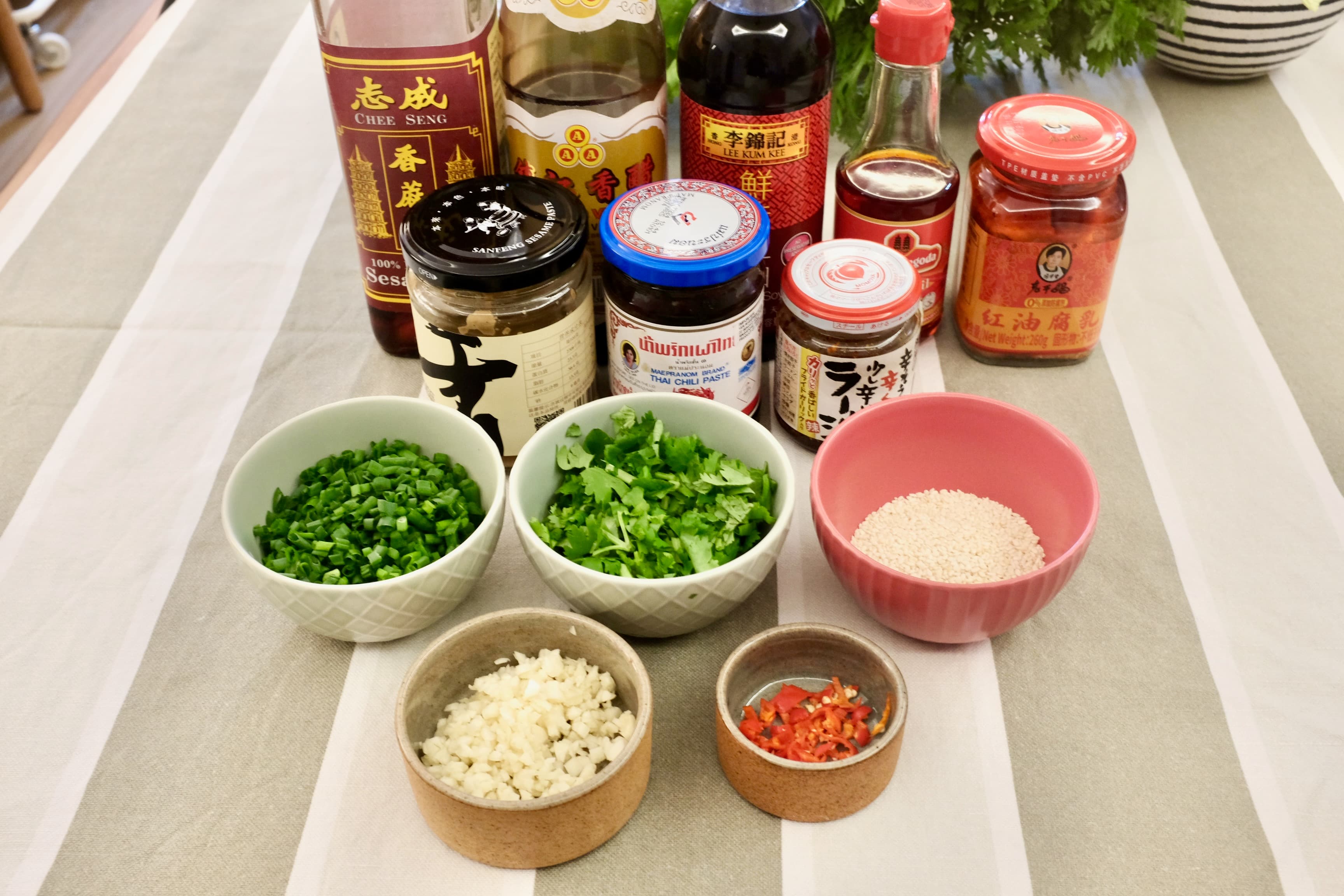
Think of dipping sauces like adding ketchup or mayonnaise to your french fries. They’re certainly not essential, but make the dish so much better. Similarly, dipping sauces add flavour to your cooked ingredients and the best part is that you can customise them to your preference.
Inspired by the condiment bars you can find at hotpot restaurants, we’ve put together a list of popular condiments you can mix and match to create your perfect sauce. We’re not going to recommend any particular combinations, but suggest that you try various mixtures and see what resonates with you. Dipping sauces can be as simple as a single ingredient, or as complex as you want.
To prepare your condiments bar, set an area aside, ideally away from your primary hotpot area, that people can go to and build their dipping sauce. Sauces, spices, oils, vinegars and seasonings can be left in their bottle/container or pour out a bit into a small dedicated bowl and provide a spoon for scooping. Chop any fresh aromatics like chilli, garlic, ginger, coriander, and spring onion and place those into bowls. Provide each guest with a bowl to add their dipping sauce to, which they can refill from the condiments bar throughout the meal.
Cooking Hotpot
Setting the Table
Put your heating element in the middle of the table and set your pot on top. Lay out bowls and eating utensils for each guest, then distribute the cooking utensils. Bring your broth to a simmer on your kitchen stove while you plate the prepared ingredients.
Transfer ingredients onto plates and bowls and lay them on the table wherever there’s space. It’s perfectly fine to combine different ingredients on the same plate to maximise space usage, but try not to mix raw meat and seafood with other ingredients to avoid cross-contamination. Don’t worry if you can’t fit everything on the table; you can bring in more ingredients as the first ingredients out are cooked. Feel free to keep extra ingredients chilled in the fridge while you finish the first batch and replenish as needed.
Once everything is laid out, carefully pour your simmering broth(s) into the hotpot and turn on the heat. Leave some space to add ingredients and don’t overfill the pot; any extra broth can be added to the hotpot later as needed. A good rule of thumb is to leave 5 cm of space at the top.
This is a good time for guests to put together their dipping sauces. When the broth reaches a slow boil, you’re ready to cook!
Cooking the Ingredients
While there’s no hard and fast rule about when to cook specific ingredients, you’ll probably want to add ingredients that take longer to cook, such as root vegetables, and ingredients that add plenty of flavour, like mushrooms, first, to gradually season the broth and to give the ingredients time to cook. Starchy ingredients like noodles, potatoes and dumplings can thicken the broth with their starch, which may not be preferable at the beginning, so consider adding them towards at the end.
Use the dedicated cooking chopsticks and/or tongs to pick up the ingredients and add them into the hotpot. If picking up raw meat and seafood, especially, avoid touching other ingredients when handling the utensils to avoid cross-contamination.
Allow each ingredient to cook until tender; thinly sliced meats may need no more than half a minute, while some vegetables may take 10 minutes or longer. Be safe and make sure each ingredient is fully cooked before eating. On the other hand, overcooked meat and seafood can become chewy and rubbery, while wilted vegetables are no fun to eat.
Give each ingredient the perfect time it needs, then use the chopsticks/tongs or strainers and ladles to pick up the cooked ingredient and add it to your own bowl.
You’ll want to aim to maintain your broth at a low boil for best results. This means you’ll have to make regular adjustments to the heat as ingredients get added and removed. Don’t add too much food at a time as the temperature will drop drastically and make everything take longer to cook. And don’t leave the hotpot at a violent boil because more fragile ingredients like fish and tofu might break apart.
As you cook, the amount of broth will naturally dip over time due to cooking, drinking, and evaporation, so you’ll have to top it up regularly. If you have extra broth, you can use that first, otherwise adding hot water is good too. After topping up, give the broth time to come back to a slow boil before continuing to cook to make sure the broth is at a safe temperature for cooking.
Hotpot Etiquette
Hotpot is a communal affair, and rules differ from group to group, but keeping these general guidelines in mind will go a long way towards everyone having a happy dining experience.
- Use the dedicated cooking utensils. If they have been provided, use them. It’s more hygienic then using your chopsticks to pick up and fish for ingredients. If you do use your own chopsticks to pick up raw meat and seafood, make sure you leave your chopsticks in the hot broth for a few seconds to sterilise it.
- Don’t mix broths. Different broths have different flavours, and keeping them separate prevents flavour blending. You might also have separate broths to cater to different dietary preferences or allergies. Respect that and don’t transfer ingredients between broths. If you want to mix flavours, do that in your own bowl.
- Eat only what you cook. If you’re not sure if an ingredient’s yours, check with the table. Don’t take something that someone else has been patiently cooking. Or worse, you might take something that was recently added and is still undercooked.
And that's it! A hotpot is a meal of abundance and sharing. Make sure you have enough to feed everyone. If you have leftover ingredients, you can have your own personal hotpot or use them in meals throughout the week. It’s also a meal of low hassle and stress, so don’t get too hung up on how to have the best hotpot. Just cook some ingredients in a yummy broth and eat it. The most important thing is to have a great time with friends and family.
Hotpot Builder
Hungry yet? Your hotpot menu is 30 seconds away.